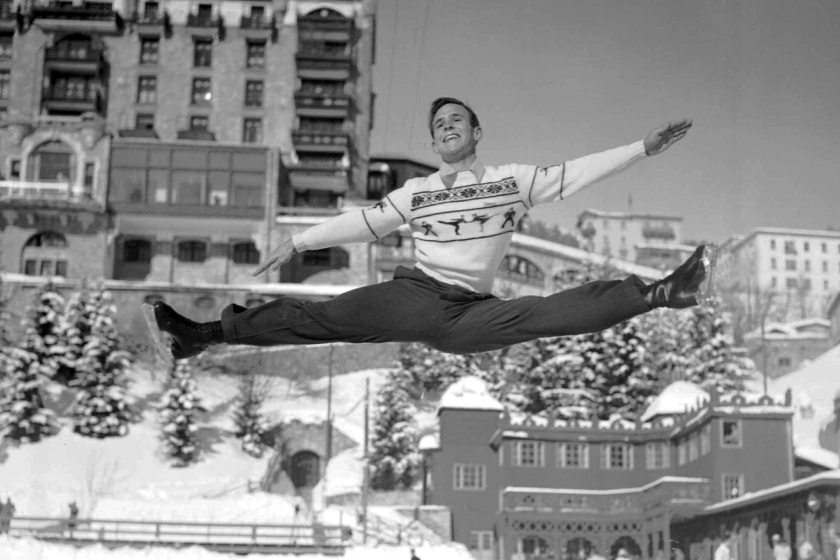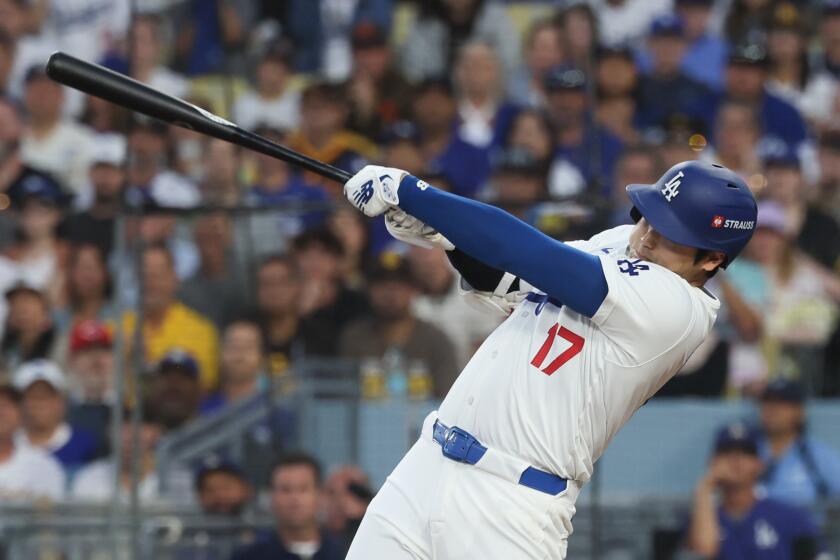The Thrill of Victory, the Agony of Heartburn
- Share via
‘You are about to witness the single most important sporting event to take place in Los Angeles County since the 1984 Summer Olympics!”
Thus hollered Rich Shea to a group of perhaps 100 rain-soaked and rather bewildered-looking UCLA students who had gathered before a makeshift stage in the middle of campus. Though the event may have piqued their adolescent attraction to the bizarre and base, or offered an alternative to studying, they almost certainly wouldn’t have called it “important,” or even a “sport,” much less one begging comparison to the Olympics.
What they had gathered to watch on this January night was an eating contest that pitted five UCLA students against five heavily booed foes from USC. The contest, sponsored by Carl’s Jr. and sanctioned by a little-known organization called the International Federation of Competitive Eating, had been billed as a precursor to the next night’s UCLA-USC basketball game.
Shea, the group’s president, had flown in from New York and brought with him two “gurgitators,” as competitive eaters are known--Sonya “The Black Widow” Thomas and “Hungry” Charles Hardy, ranked second and sixth in the world, respectively. Thomas, an affable, smiling, skinny Korean American, was chosen as captain of the UCLA team, while Hardy, a laconic 340-pound corrections officer with a passing resemblance to the Comic Book Guy on “The Simpsons,” was to lead USC.
The rules were simple. The team that ate the most hamburgers in 10 minutes would win. Whoever ate the most burgers would go home with $1,000, provided by Carl’s Jr. Everyone knew that either Thomas or Hardy would get the money, of course. After all, Hardy held the world records for shrimp cocktail and boiled cabbage, and Thomas for tacos and chicken wings, among others. The chief goal for the students was to keep from vomiting.
“Pace yourself,” counseled Shea as the students huddled, throwing nervous glances at a banquet table piled high with low-carb burgers--wrapped in lettuce instead of a bun.
“If you suffer urges contrary to swallowing”--”What?” said one of the kids; “Puking!” said another--”If you suffer urges contrary to swallowing,” Shea resumed, “you’ll be disqualified. If you feel yourself getting uncomfortable, stop, and, if you get the, you know, urge . . . “--Shea made a subtle rolling hand gesture in front of his torso--”we’ll put some buckets in back.”
The contest began, and 10 minutes of flying burger wrappers, loose tomato chunks and dribbling mayonnaise later, it ended. Thomas and Hardy split the purse, eating seven burgers each--disappointing results for Thomas, a woman who once consumed 65 hard-boiled eggs in less than seven minutes. USC won the team competition. More importantly, nobody hurled.
Welcome to the sport, or pastime, or grotesque diversion, or masochistic fin de siecle food-fetishizing ritual--call it what you will--of competitive eating.
Thanks in large part to the federation, competitive eating has taken off in the past five years. There are now contests on most weekends of the year in cities all over the world. The contestants devour everything from the mundane--steak, pizza, dumplings--to the mildly ethnic--cannoli, sushi, tacos--to the downright repulsive and sadistic--jalapenos, braised calf brains, whole sticks of butter. During the past few months, there has been a deep-fried asparagus contest in Stockton, a corn contest in West Palm Beach, a corned beef and cabbage contest in New York City and an oyster contest in New Orleans. And those are just the events the federation officially sanctions.
The purses and prizes, though typically paltry, are getting larger. They usually consist of no more than $500 to $1,000 and a big doggie bag. But at the 12th annual Wing Bowl, held at the end of January in Philadelphia, Thomas ate 167 wings in 30 minutes and won a new $20,000 Suzuki Verona.
The crowds are getting bigger, too; 22,000 people attended the Wing Bowl this year. Competitive eating has been covered in major publications such as the New York Daily News and Sports Illustrated, on late-night talk shows and on thousands of fan websites. Takeru Kobayashi, the federation’s top-ranked eater, is mentioned on more than 1,800 Google sites.
And that is precisely the point. In the end, the hamburger gobble wasn’t really hyping the basketball game or furthering the age-old UCLA-USC rivalry, but promoting Carl’s Jr. It was a public relations stunt, a coverage opportunity whose sole purpose was coverage.
All of which is fine with the 35-year-old Shea, a PR man who founded the federation 10 years ago with his brother, George. Their intention--as its website states--is “communication, cooperation, and uniformity in the regulation and supervision of competitive eating.”
It is difficult to tell when the boyish-looking Shea is speaking tongue-in-cheek, and his fascination with gluttons is hard to figure out. Shea says he has never had a weight problem and has no particular preoccupation with obese people, although he did once represent a 1,000-pound man who had to be brought out from his home on a whale stretcher. But there is no doubt he is fascinated--even passionate--or that he is trying to create a phenomenon and is doing a decent job. (On the strength of her performance--sub-par though it was for her--Thomas stayed an extra day in Los Angeles so that she could appear on “Jimmy Kimmel Live.”) Shea and his group have not gone the way of the XFL yet, and you’ll see more articles written on his contests than on professional badminton.
Scoff if you must, but Shea considers himself a sports promoter and believes competitive eating is a sport. “The next baseball,” he often calls it. When it comes to promoting a new venture, organic growth is commendable, but it won’t get you corporate sponsorship or put you on “20/20,” where Shea appeared in January, fielding questions from a perfectly incredulous Bill Ritter.
“The definition of sport is any physical activity governed by a set of rules, so ours is clearly that,” says Shea, sitting in the federation’s midtown Manhattan office. “But it’s also a refinement of skill. It’s a mental game. It’s a physical game. People say, ‘That’s not a sport, that’s just eating.’ Well, running and jumping are inherent to man--so is eating. David Wells looks more like a competitive eater than a baseball player, but he’s a [great] pitcher. There’s a parochial attitude that we face, obviously.”
Obviously. But there is something mesmerizing--in an old, parochial, human fashion--about watching a string-bean-sized woman and a 340-pound man stuff inhuman amounts of food into their maws in a very short period of time. It’s not unlike watching a contestant win $1 million on a game show; you can’t quite believe the sight of someone merging themselves with so much of a commodity so quickly.
Nor is it unlike an episode of “Ripley’s Believe It or Not” or “When Animals Attack.” Such is the kind of beguilement and morbid curiosity Shea is depending on. In a country undeniably taken with watching all forms of extreme competition and conspicuous consumption, and where 30% of adults are obese, the willingly beguiled and morbidly curious--as well as the food-obsessed--are surely out there to be entertained.
In addition to sanctioning and supervising contests, the federation keeps updated rankings of the world’s top eaters, lobbies restaurants and food companies to create contests, recruits and grooms new eaters and seeks out media coverage. Shea fell into the sport when his PR firm, Shea Communications, which he runs with his brother, was hired to promote the annual July 4th Nathan’s Famous hot dog contest, itself a publicity stunt created in 1916 to promote its Coney Island restaurant.
The Nathan’s event is the oldest-known recurring contest in the country, the Super Bowl of competitive eating and a right of passage for all serious competitors. “You’ve got the Macy’s Thanksgiving Day Parade, the Rose Bowl Parade and the Nathan’s contest,” Shea says in his typically dramatic style. At Nathan’s, reputations are made and rankings rise and fall.
For Shea, the contest is his model. It receives more media coverage each year--ESPN covers it like it would any major sports event--and it draws strictly the best eaters. Perhaps most impressively, it carries the aura of a championship game, with highlights appearing on the local news and fans who missed it checking the results as they would box scores.
It was at the 2001 Nathan’s contest where willowy 23-year-old Takeru Kobayashi exploded onto the scene by packing 50 hot dogs into his diminutive frame in 12 minutes. Kobayashi is currently ranked first in the world and is arguably the best-known competitive eater ever. (Ask a passerby about eating contests, and he or she will probably mention “that little Japanese guy who eats all the hot dogs.”) Kobayashi and a handful of other Japanese competitors who come to the U.S. only once or twice a year are superstars back home, and Shea is depending on them to carry the federation’s banner overseas. It’s an odd turn of events, since scholars of competitive eating--such as they exist--believe the sport actually began in Japan.
Like sumo wrestling or the absurdly humiliating human-stunt game shows now popular there, it seems to fulfill a national need--perhaps more palpable than America’s--for exploring bodily extremes. Eating contests in Japan are baroque, with 20-foot-long rows of sushi extending down bowling lanes, or conveyor-belted bento-box battles on mountaintops. The best Japanese eaters are capable of consuming unimaginable quantities; Kobayashi, who has eaten 17.7 pounds of braised calf brains in one sitting, can ingest more than 20 pounds of food. Whether attributable to practice (it’s been rumored that, before contests, the Japanese drink gallons of water and eat whole watermelons to expand their stomachs), or to the mythical Asian capacity for concentrating and withstanding pain, the federation is not willing to speculate. “We don’t endorse any training methods,” Shea says.
Kobayashi, who stands 5’ 7” and weighs about 145 pounds (on an empty stomach), also has lent credence to the much-discussed “Belt of Fat” concept, a pseudoscientific principle that has recently sent theory-of-relativity-like shockwaves through the eating circuit. While many competitive eaters are of normal size, just as many are overweight, and quite a few are obese. But the Belt of Fat theory holds that thin people can ingest more food than overweight people because their stomachs are not constricted by fat and therefore can distend farther. An electrical engineer and retired competitive eater named Ed Krachie, whom Shea describes as a “Mickey Mantle-like figure” in the sport, submitted an article on the theory to the New England Journal of Medicine, which, unsurprisingly, did not accept it. “There were no footnotes,” Shea explains. “They were very buttoned up about it.”
Eric Booker, ranked fourth in the world, is a subway conductor in New York City. He stands 6’ 5” and weighs about 380 pounds. Booker is widely regarded as the most versatile eater on the circuit, with world records in burritos (15 in 8 minutes), peas (9 1/2 pounds in 12 minutes), doughnuts (49 in 8 minutes) and--in what he considers his finest achievement--cheesecake (12 pounds, or 37,000 calories by his tally, in 6 minutes).
Booker, a warm, talkative, gentle-giant of a man, lost to Sonya Thomas in January’s fruitcake contest in Buffalo, N.Y., by an eighth of an ounce. (“That must have been some scale,” he complains.) But there is no time to pout; he has another contest in two weeks--matzo ball-eating at a deli near Times Square. For practice, Booker takes on six matzo balls without broth, each the size of a man’s fist. Booker discloses his mantra--”stay hungry, stay focused”--and espouses the four tenets of his “Sweet Science of Competitive Eating”: stamina, strategy, capacity and a strong, focused mind. Today he is practicing strategy.
“I will look at the matzo balls, you know, talk to them,” Booker says, “What’s the quickest way to eat you? Interrogate my food.” Deciding the quickest way would be simply to jam the matzo balls into his mouth as rapidly as possible, he pulls a Palm Pilot from his pocket and sets the stopwatch feature. Thirty-one seconds later, three of the matzo balls are gone.
What appeals to him about this gastric pastime? “The competition,” Booker says. “Not only is it respected by top sports journalists, but it has all the elements of a sport. You have to train, you have to strategize, you have to be in good shape. Good eating shape. Not like Bruce Jenner or Carl Lewis. You have to have a strong jaw. There’s lots of hard movements. It’s just like running, in terms of stamina. You have to pace yourself.”
Booker, who is 35, has three children, ages 11 to 19. How does his family feel about the eating? “My wife loves it,” he says, not too convincingly. “She encourages me.” But after she saw footage of him at the previous summer’s Nathan’s contest, she insisted that he lose some weight. He’s down from 440 pounds.
“My heart’s good. I don’t have diabetes,” he says. “I just decided it was time.”
He pulls out a photograph taken on their wedding day, 13 years ago. There stands a muscular, unrecognizable young man. Does seeing his old self bother him at all? “Nah,” he says.
Booker’s other motivation is the attention that competitive eating brings. He has been written up in Maxim, Sports Illustrated and, improbably, the Wall Street Journal. He also has appeared on the “Today Show,” “Last Call with Carson Daly” and “The Sally Jessy Raphael Show.”
Asked if people stop him for his autograph, he answers, “Oh, my God, all the time!” He raps, mostly about eating, and has recently recorded an album called “Hungry and Focused.” Not long ago, Booker ran into Big Boi, half of the hip-hop duo OutKast and one of his favorite artists, who remarked: “You always losing to the little Japanese guy!”
If Booker represents competitive eating’s present state in America--a magnet for overweight hobbyists--Sonya Thomas is its future. Or so she and the federation hope. Dubbed “The Black Widow” (“Because I eat all the men!”), Thomas is 36 and lives in Virginia, where she moved seven years ago from South Korea. She holds the world record in consuming oysters (432 in 10 minutes), the stuffed turkey-duck-chicken composite known as turducken (7 3/4 pounds in 12 minutes) and pulled-pork sandwiches (23 in 10 minutes), in addition to those for tacos, chicken wings and hard-boiled eggs. She is single, and once quit her job as manager of a Burger King at Andrews Air Force Base to devote all her energy to the sport.
“I love my job, but I love the competition too,” she says over the phone from Virginia. Rail thin, she exercises five times a week, walking seven miles on a treadmill. While the media attention doesn’t displease her, what she really wants is to be the greatest competitive eater in the world.
Thomas says she’s always been able to eat enormous quantities of food. (At the Burger King, which she has returned to, she winds down from a shift with three king-sized orders of French fries.) Although she had seen competitive eating contests in Japan, she didn’t know the sport existed in the U.S. until two years ago, when she saw Kobayashi win the Nathan’s contest on TV. The next year, she entered a Nathan’s qualifier. In her first contest, she ate 18 hot dogs. Until then, women competitors typically topped out at about 10. A week later, at Coney Island, she ate 25. How does she do it?
“I want to be the champion--and then I just concentrate,” she says. “You cannot taste the food, you have to concentrate on swallowing.” Before she starts, she envisions herself holding a trophy. “As long as they give me more than 12 minutes, I can beat anybody on the circuit. Women can eat just as much as men. I don’t like to be told that women can’t be champions.”
If you are Rich Shea, and you believe that eating contests should hold appeal for anyone competitively minded, Thomas is an ideal icon for the sport. She shows that competitive eating is a pure meritocracy, that it doesn’t have to portend obesity and that there is room for specialization. Whatever kind of food you prefer, there are several contests for you. And if she can keep winning, Thomas may prove to be the first “gurgitator” to make the sport her livelihood. “She is the most exciting thing going on in competitive eating right now,” says Shea, with the zeal that NBA Commissioner David Stern might reserve for LeBron James.
Still, one has to wonder what goes on in the minds of competitive eaters, particularly those such as Booker, whose weight and eating habits pose an obvious health risk. Michael Strober, director of the Eating Disorders Program at UCLA’s Neuropsychiatric Institute, said via e-mail that it is “unlikely that the social processes that have been implicated in cultural models of ‘ideal’ weight and shape are operating here.” The sport, he added, “may represent, at least for some of these ‘competitive eaters,’ an occult means of channeling clinical disturbances of eating behavior--e.g., the obese binge eater, or the underweight binge eater--in some atypical, albeit ‘officially sanctioned’ manner.”
Shea considers such issues beyond his control. “It’s just not my deal,” he says when asked about the competitors’ health. “I know they don’t compete during the week. I know that every contest we run is safe. We make sure there are EMTs present. We make sure the contests aren’t hours long, and we make sure everyone is over 18. Outside my events, I really can’t hold everyone’s hand.”
Does Shea ever worry that competitive eating glorifies what has been called America’s “culture of excess”?
“It’s a luxury to compete with food, obviously,” he says. “But Americans are overweight not because there is a Nathan’s hot dog-eating contest every year. Americans are overweight because they go to a warehouse store and drive out with a pallet of sugary soft drinks and five cases of trans-fatty, salty snack foods, you know?”
More to Read
Go beyond the scoreboard
Get the latest on L.A.'s teams in the daily Sports Report newsletter.
You may occasionally receive promotional content from the Los Angeles Times.






